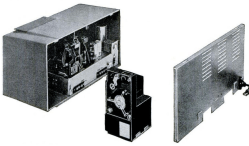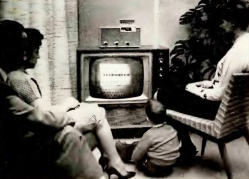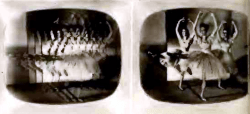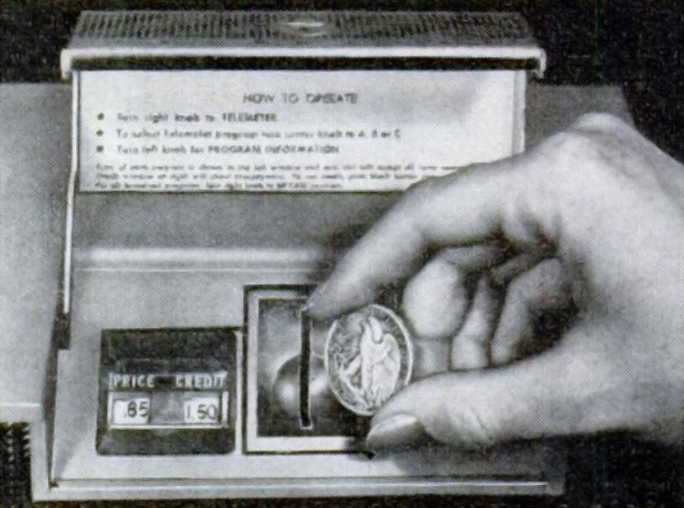These days, paying for TV programming is a fact of life. You pay your cable company or some streaming service and the only question is do you want Apple TV and Hulu or would you rather switch one out for NetFlix? But back in the 1960s, paying for TV seemed unthinkable and was quite controversial. Cable TV systems were rare, and the airwaves were a public resource, so allowing someone to charge to watch TV on the public airwaves was hard to imagine. That was the backdrop behind the Telemeter — an early attempt to monetize TV programming that was more like a pay phone than a modern streaming service.

[Lothar Stern] wrote about the device in the November 1959 issue of Popular Mechanics (see page 220). The device looked like a radio that sat on top of your TV. It added a whopping three pay-TV channels, and inside was a coin box, and — no kidding — a tape punch or recorder. These three channels were carried from a Telemeter studio over what appears to be a dedicated cable strung on existing phone poles.
Of course, TVs with coin boxes were nothing new. But those TVs were found in public places, airports, and hotels. The money was simply to turn the TV on for a set amount of time. This was different. A set-top box unscrambled channels delivered over a dedicated cable. Seems like old hat today, but a revolutionary idea in 1959.
At Home
The Telemeter had a control labeled “Program Information” that played an audio description of the three programs currently available. A bypass allows the user to tune in normal free TV as well. The Telemeter itself broadcast on either channel 5 or 6, assuming one of these channels was open in your area.
Suppose you heard that something you wanted to watch was on channel “B.” You’d turn to channel five on the TV and set the Telemeter to channel B. You’d lift a little lid on the box and find a window with the price of the program. There would also be a coin slot for you to insert your money. The box didn’t make change, but it would give you credit for excess money against future purchases.
Why a Tape?
The tape device inside wasn’t for programming. It registered what programs you’d paid for. Every month or two, someone would visit your home, empty the coin box, and switch tapes. The data on the tape told the company what shows you watched, which allowed them to pay providers and gather statistics. It also made sure the coins in the box matched the amount charged. Here you thought that companies monitoring your viewing habits was a modern thing!
At first, it might seem hard to imagine that someone would visit your home to empty out a coin box, but until recently, most electric, gas, and water services were the same way. Typically, but not always, the meters were outside your home, so they didn’t enter, but it was the same idea. Had the Telemeter caught on, it would be easy to imagine a system where your usage was on credit and the tape outside your house would generate your bill.
The practical problems of people swindling your coin acceptor — like they did with payphones — would have been an issue. Not to mention people simply hacking the device.
Business
Paramount was interested in the technology and bought 50% of the company in 1951. In 1952, they performed a brief test of their scrambling technology on the air in Los Angeles. By 1953, they had wired up a network in Palm Springs, California. Need some bar trivia? The first feature film on pay TV was Forever Female staring Ginger Rodgers and William Holden. There were 70 homes that could have watched it, and the cost was $1. One of those 70 homes, by the way, was owned by Bob Hope.
Things changed in 1954. The service had 148 users, with more waiting for service. An average subscriber was dropping $10 a month on movies. But drive-in theater owners sued, and it became hard to source movies for the fledgling service. The service shut down in 1954, but Paramount wound up owning the entire company. lt’s no surprise that movie theaters were dreadfully frightened of pay TV, but check out the theater ad below.
Back to our story. In 1959, the service was reincarnated as a Canadian company that carried on until 1965. In 1960, they connected 1,000 subscribers in Ontario. Despite adding sporting events and original movies, the service did not prosper. It peaked at 5,800 homes in the area around Etobicoke, Ontario, a suburb of Toronto, but when it ceased operation in 1965, there were only 2,500 users. At the peak, reports claim the average subscriber spent $0.80 a week (or about $1.22 a week if you exclude people who didn’t watch anything).
Cost

So, what did this modern convenience cost? The Palm Springs network charged almost $22 to install the box. A movie typically went for $1 to $1.25. The first program was a college football game that cost $1 and Telemeter claimed that 97% of users tuned into the first broadcast.
Palm Springs had an early master antenna system so residents could receive TV from Los Angeles. That was a $162 install plus $65 a year, so the $22 was not that high.
The cost was a lot less in the Canadian incarnation. According to the article, you paid $5 to have it connected, but keep in mind that $5 in 1959 was more like $50 today. That was enough to buy five gallons of milk, 20 gallons of gas, or take five people to the movies. Presumably, the company made their money by emptying your coin box every month.
The price per program was said to vary. There could be sponsored free programs, too, but you could expect those to have commercials.
Other Systems

Zenith experimented with Phonevision to deliver programming using broadcast frequencies and phone lines. That isn’t surprising since Zenith had looked into pay television as early as 1931. In 1951, some Zenith TVs had connectors for Phonevision. The system required the user to call an operator to be placed in a queue for a particular movie. When the movie was available, the set top box would receive instructions via the phone line to unscramble the movie. The bill showed up on your regular phone bill. Depending on who you asked, the system was a flop or a success. The scrambling method, however, was not compatible with color TV, so there was a definite limit to the technology.
RCA and Skiatron had Subscriber-Vision. This was similar to Phonevision, but used punched cards instead of a phone line. You’d insert the card to start decoding. A new card arrived in the mail every week. Initially, the card was a normal IBM punch card, but those were easily duplicated. Later versions used a “translucent card” with “a circuit printed in metallic ink” (that from Sponsor Magazine’s May 1952 edition).
In 1957, a famous system in Bartlesville, Oklahoma, ran briefly. It was more like a modern cable system. The service provided a descrambler for a monthly fee.
The Zenith system was as early as 1951, but all were victim to the FCC’s indecision about pay-per-view. If the FCC allowed over-the-air scrambling, it would change the landscape. If they didn’t allow it, then things like Telemeter or Phonevision would be necessary. It would be 1961 before the FCC allowed real tests and 1963 before Zenith did the first over-the-air test.
Future
Of course, cable TV systems made anything like this seem silly, and the Internet is in the process of wiping out cable TV. But this wasn’t always obvious. Even the president of Zenith TV said that it would be too expensive to wire large areas like Los Angeles or New York with cable TV.
The company behind the Telemeter, the International Telemeter Corporation, persisted as part of Paramount and its owners for a number of years and tried to create pay-per-view equipment and systems, but it was just too early. For example, they offered a box that would let cable operators accept a quarter to display cable TV for an 18-hour period. While paid services would eventually be the answer, it would arrive much too late for Telemeter to be more than a historical footnote.
There were a lot of gizmos associated with early cable TV. Everyone wants to know about the weather and cable operators were happy to oblige. Then, the weather went high-tech, at least by the standards of the day.

















The local utilities (gas, electric and water) still visit my house every month. Gas and water meters are read wirelessly from a truck driving slowly down the street, but the guy from the electric company still walks to each house to actually look at the meter. Cable and phone (yes, I still have that) just drain my bank account as they see fit on the 15th of the month.
I just have cable internet and phone. Not the TV channels option. Getting expensive as now over $100 a month just for those two services. Going to to start looking for alternates maybe this summer to see if cheaper internet access out there. Certainly don’t need the bandwidth. May even drop the phone at this rate even though we like a home phone. Got you coming and going….
“These days, paying for TV programming is a fact of life”? [spicier derisive deleted] Nonsense. The TV in my shop receives dozens of over-the-air (OTA) channels for free.
I’m glad they don’t charge for the commercials. ;-)
I get free TV and movies without ads. How? Oh you know how
And with ATSC 3.0, OTA TV could become pay TV with the DRM that is built into the system.
The original Edison DC system used a metal nail in a jar of acid to measure how much current you were using, by how much weight the nail lost by electrolysis.
I grew up in a single parent family in the UK in the 80s. We were always skint & everything was on meter. The one next to the telly would dole out varying numbers of hours per pound coin based on how far in the hole to Rumbelows or (mental mental) radio rental we happened to be that month.
I remember the “trick” of rolling the coin through multiple times
Wow. It’s incredible what perverted ideas a human mind can develop, I think.
Some people seem to see money making in about everything.
If only same amount of creativity and energy was spent to produce high quality documentaries and school programme.
Free, barrier-free television had such a potential to educate citizens and widen their mental horizon.
Let’s imagine if, say, universities or schools had the license to maintain their own free TV stations.. Maybe with a certain power limit and under some supervision (to prevent propaganda).
It’s cute that you think anyone would watch these university TV stations.
The Open University in the UK did that via the BBC from 1971-2006, hardly a bad run.
And it’s a reflection on your intelligence that you think no one would.
i remember seeing these things at bus stations when i was a kid. they were black and white with maybe a 5 inch screen at most. a quarter bought you 15 minutes of fuzzy broadcast tv.
“paying for TV programming is a fact of life”
Only if you choose. There is life without the idiot box, you know.
Back in the 80s the pay TV scrambling system involved sync-shifting. Two methods were popular. One just imposed a sine wave on the whole video signal that was synchronized with the horizontal sweep. A copy of that sine wave was sent usually as an audio subcarrier. The decoder box would extract that signal and add its inverse to the video. Other variants would instead use a square wave of a duty cycle such that it would just shift the horizontal blanking interval up.
The net result is that without a negative going sync pulse the TV would be unable to lock the horizontal sync and you’d get the characteristic wavy video with the black wonky bar going down the middle and every once in a while it would happen to line up so you’d get a little burst of clarity, usually with messed up color (because the color burst would not be synced).
When I was in college, I built a little box that would replace the horizontal and vertical blanking intervals with locally generated sync. You would use buttons to “roll” the picture into place and it would be perfectly descrambled. The problem was that I didn’t have a good means of demodulating the RF. I bought a broken VCR just for this purpose, but the problem was that the demodulator tried to perform AGC, but without proper sync it wouldn’t do a good job of it, so the brightness would constantly vary.
It was the end of the analog window, though, so it wasn’t too long before those channels were sent digitally – even before the advent of HD – and the whole scheme stopped working.
I remember around 1983 or so, in Worcester MA there was a scrambled “adult” channel over air. We discovered if you got two tvs, you could use the fine tuning to get the image to stop scrolling around on tv 1, then use the 2nd tv to fine tune to get the audio.
I am glad you said tantalum caps shorted more often. It recalled to memory when I was a technician in the 1980s and 1990s that yes. it was the tantalum caps. Of the 15 years as a technician a saw two tantalum caps that were shorted. One was in a used piece of equipment the other was new. Thank you for your knowledge on electrolytic caps.